Knitting Pattern for Socks on Four Needles Uk
Hello! Do you want to learn how to knit socks? You're in the right place!
People all over the world are discovering the joy of knitting socks and I'd love to help you join them! This tutorial and free sock knitting pattern will get you started … but there's more information here on this blog than just in this post so don't worry if you are a total beginner!
I wrote this post in 2014 and a year later, after yet another person told me it was too difficult for them to knit socks, I wrote the Winwick Mum Sockalong tutorials which covers everything you need to know if you've never knitted socks before. From choosing yarn and needles to sock anatomy, how to wind the yarn so that your socks match and how to work out the perfect fit for your feet … and that's before we get into the step-by-step how to knit socks tutorials themselves!
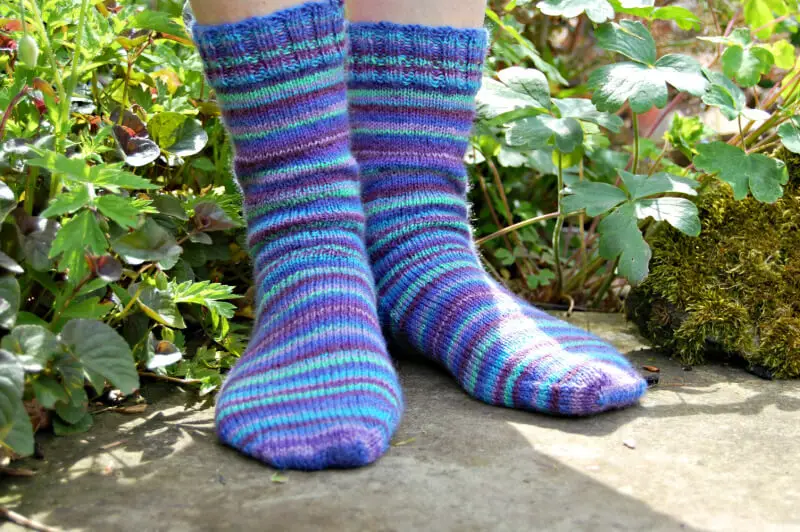
If you're brand new to socks, I'd recommend you take a look at the tutorials and download the free pattern for socks by clicking the picture below. You'll be knitting with your choice of DPNs (double pointed needles or circular knitting needles before you know it!
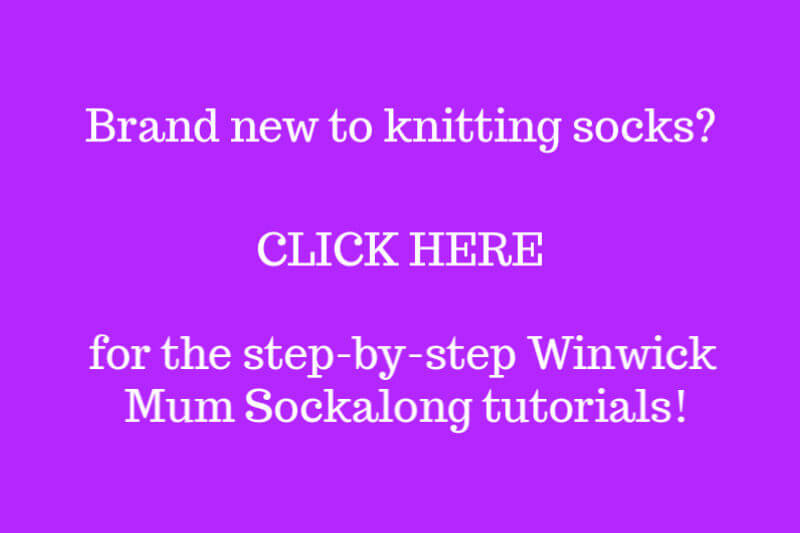
If you're just looking for the
Winwick Mum Sockalong Basic 4ply Sock pattern,
click here
or keep reading if you're not a beginner but you need a sock-knitting reminder. The following tutorial is written for a short circular knitting needle which is my preference 😀
* * *
The idea of knitting socks can be quite daunting if you've not done it before. The whole thought of turning heels and grafting toes can be quite enough to put you off before you even pick up your needles – and I know this because that's how I felt too! Now, of course, you know all about my love affair with socks … here's my latest pair. I just love the colours in this yarn, definitely my favourite combination!
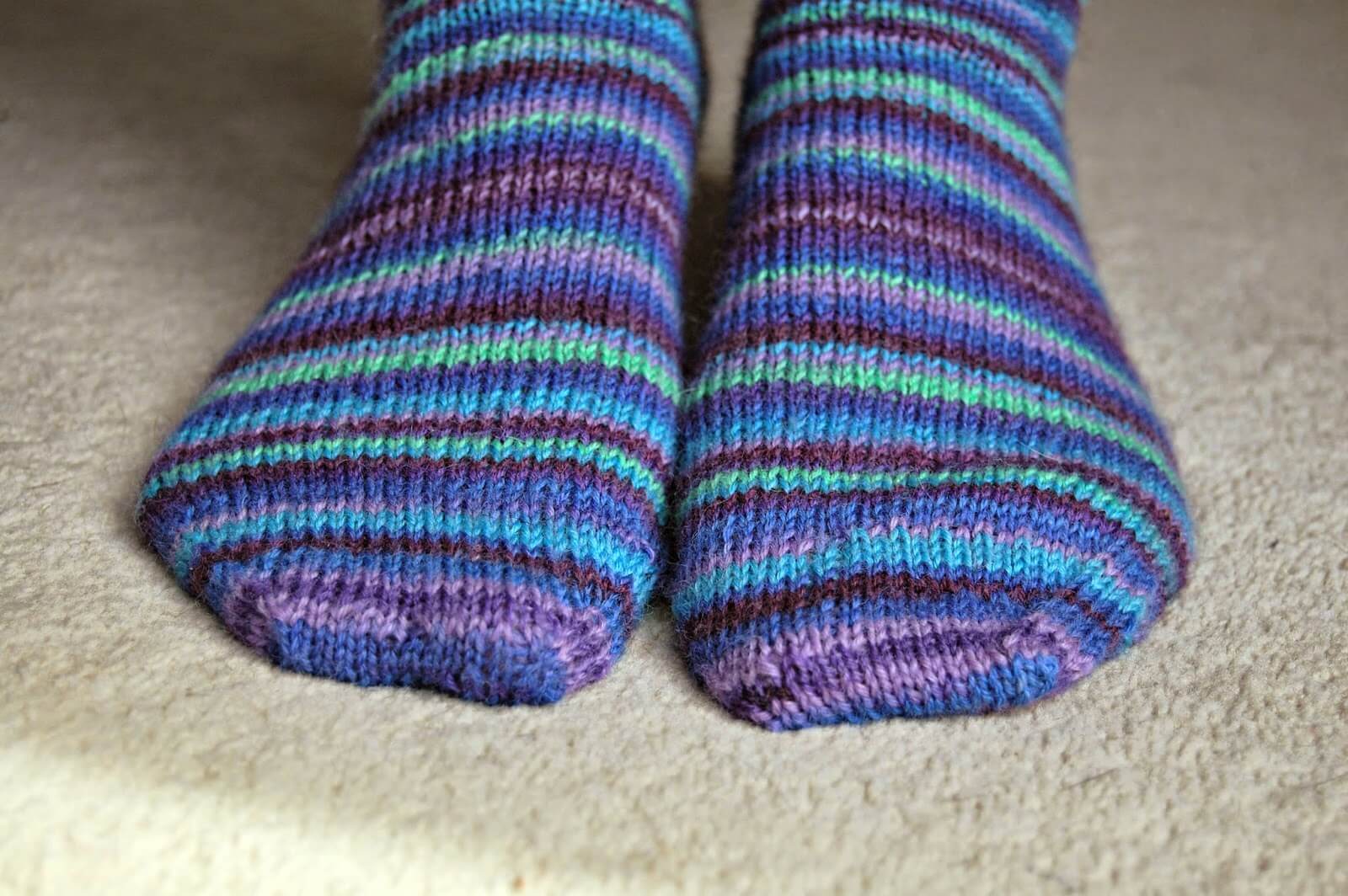
I knitted my first pair of socks for my beloved Uncle Harry when I was about 16 years old. My Aunt Ella had always knitted his socks for him and when she died, he asked whether I'd be able to make some for him as he didn't want to have to buy any. What a performance! The pattern was quite awkward, involving sewing gussets and side seams, and I wasn't sure they were anything like up to my Aunt Ella's standard. I decided I would not be making any more socks.
Fast forward to when small daughter was a baby. I was in a local yarn store buying wool for yet another baby cardigan when I spotted balls of multi-coloured yarn on the counter, along with leaflets showing knitted socks.
"They're new in," said the lady, noticing my interest. "They make lovely socks."
"Oh, I made a pair of socks a long time ago," I told her, shuddering at the memory. "I'm not sure I could face another pair."
"This is a good pattern," she said, "and you get it free with the yarn."
Ker-ching! I left the shop with baby yarn and multi-coloured yarn to make my husband a pair of socks. And this time round, the pattern was much more straight-forward. No sewing up and a heel that magically created itself thanks to some nifty decreasing. I was hooked!
A couple of pairs later, I just happened to search for sock yarn on the internet. WOW!! I had no idea there was so much sock yarn available, that so many people knitted socks, there were so many fabulous patterns out there – or that there would be so much help. I joined a knitting forum, discovered Ravelry and the couple of pairs of socks turned into something of an obsession. Now, it seems incredible to think that I ever thought there was anything difficult about knitting socks, but anything new takes some thinking about and certainly anything new that involves four or five double-pointed needles and 4ply yarn!
I know there are many sock patterns and tutorials on the internet aimed at beginners, but sometimes you just need one basic pattern that you can use to get started, increase your confidence and then adapt to suit your own feet. I'd like to share mine with you – not the free one I originally got but an amalgamation of a few versions, altered over many pairs to get it just the way that I like to wear my socks, and still being adapted to suit other members of the family.
This pattern is now the basis of the Winwick Mum Sockalong tutorials and you can find detailed instructions with lots of pictures here.
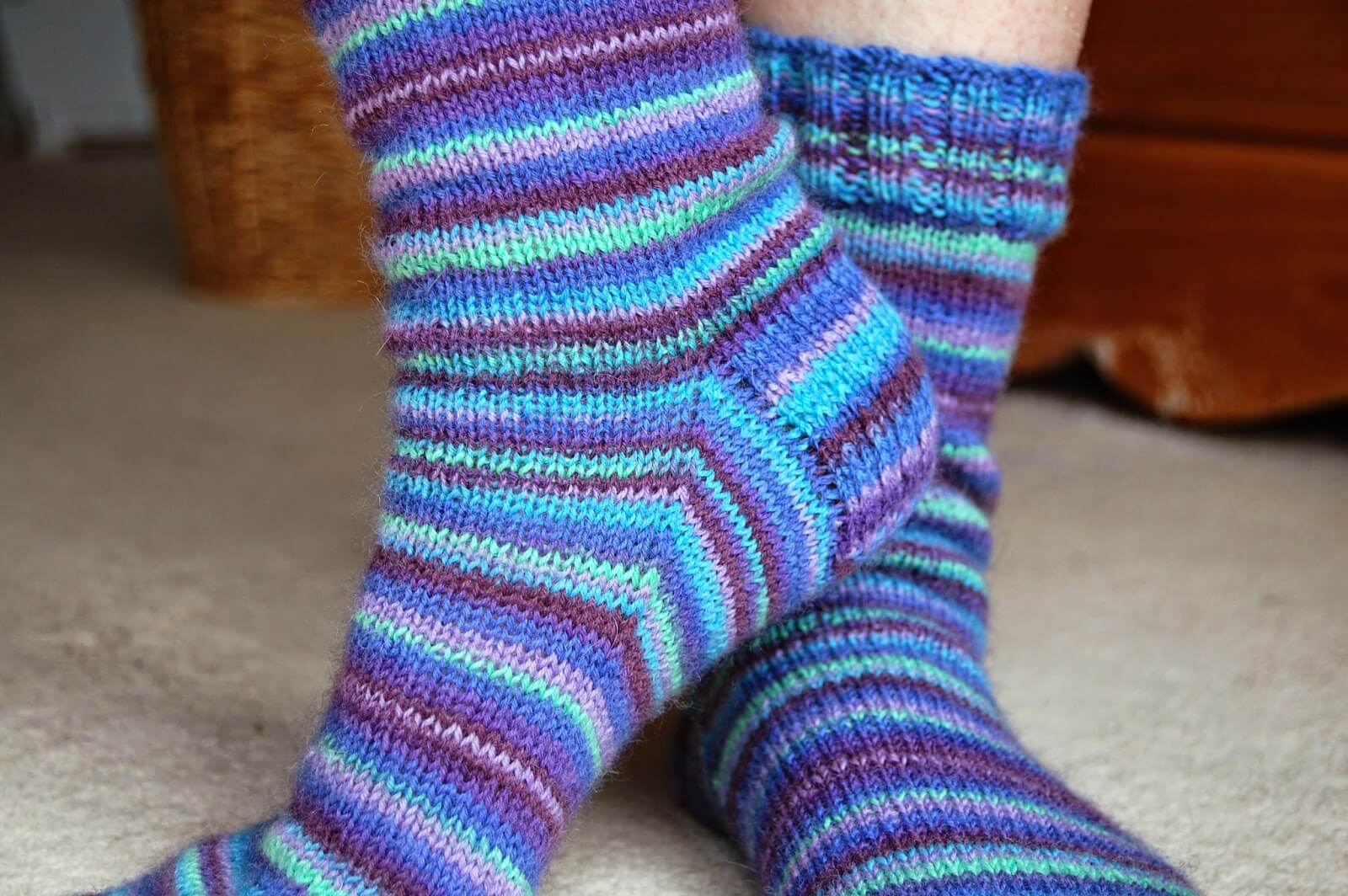
Now, before we get started, a quick word about needles. I use both double-pointed needles (DPNs) and a small circular. Mine's a 30cm Addi but Hiya Hiya also make them although in a 23cm length and you can find smaller lengths and other brands too. It's simply a matter of preference as to which one you'd choose. (More info here and here) I always cast on using my DPNs as trying to cast on with a tiny circular is a disaster – it just doesn't work for me with the cast on that I use.
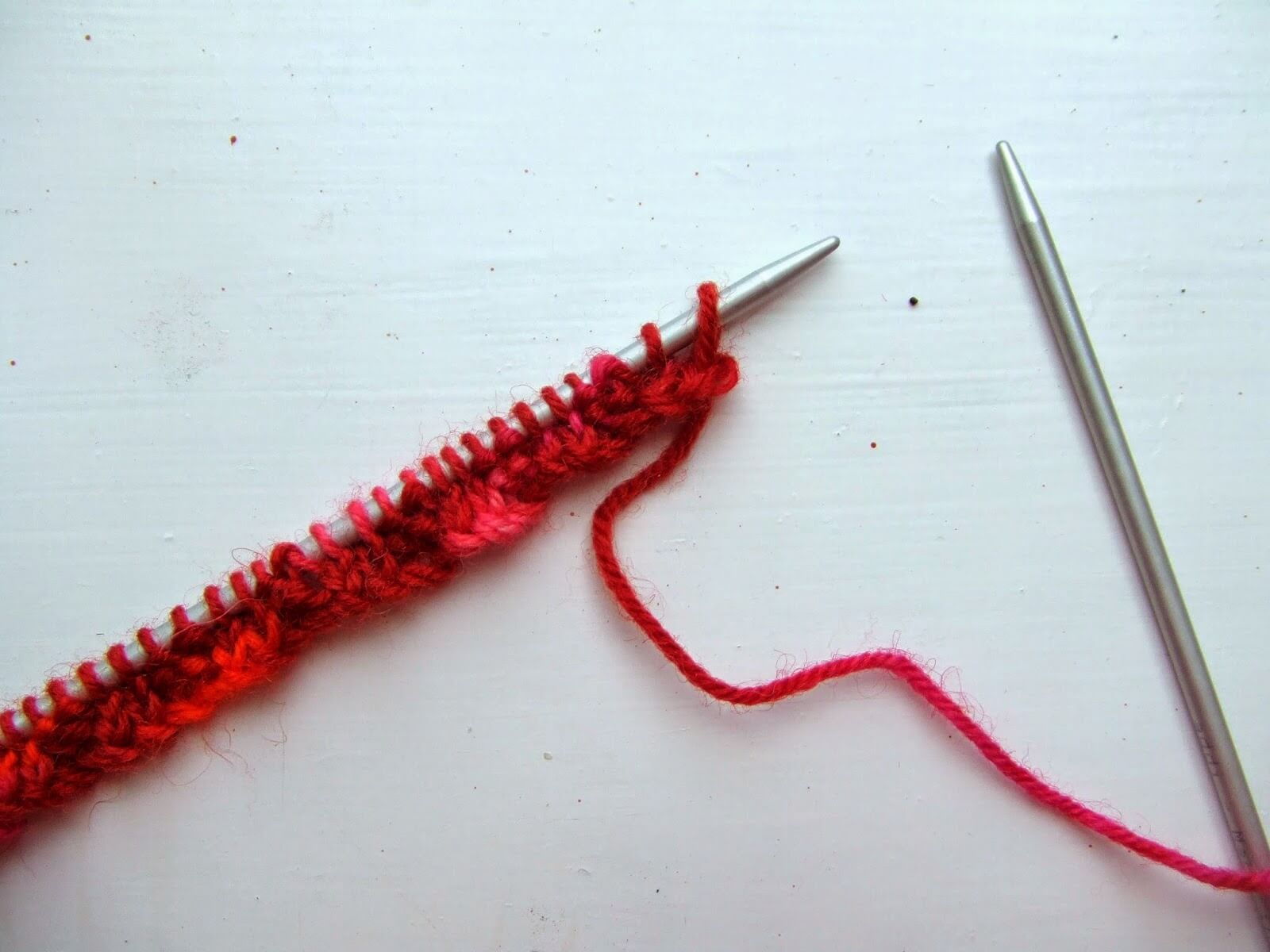
Then, after a couple of rows of rib, I transfer my stitches to my circular and off I go. I find it so much easier than knitting a whole sock on 5 needles and you don't get join lines down the socks either. Some people like the magic loop method using a longer circular and I have used that, particularly for knitting two socks at a time, but it's not my favourite method.
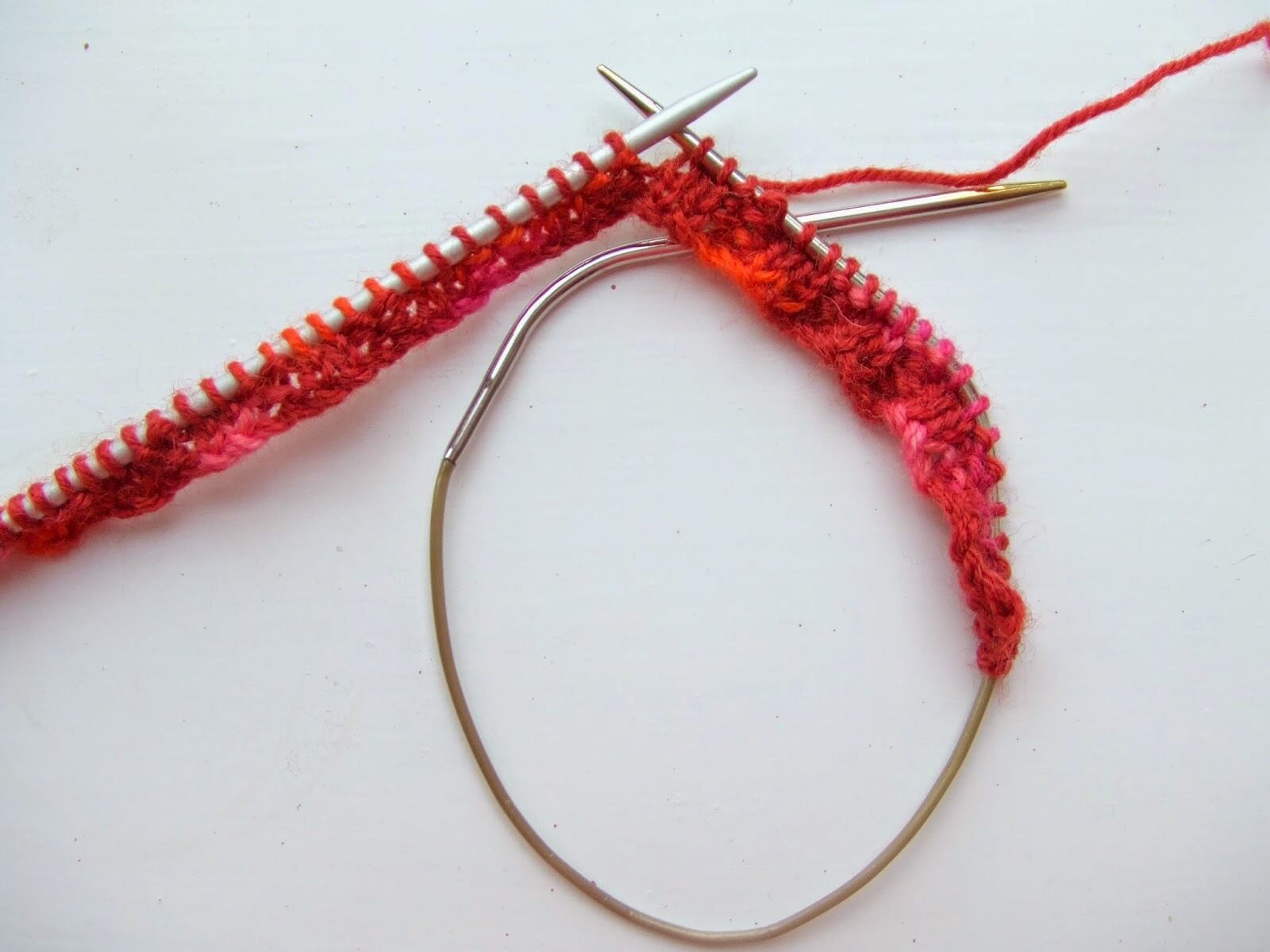
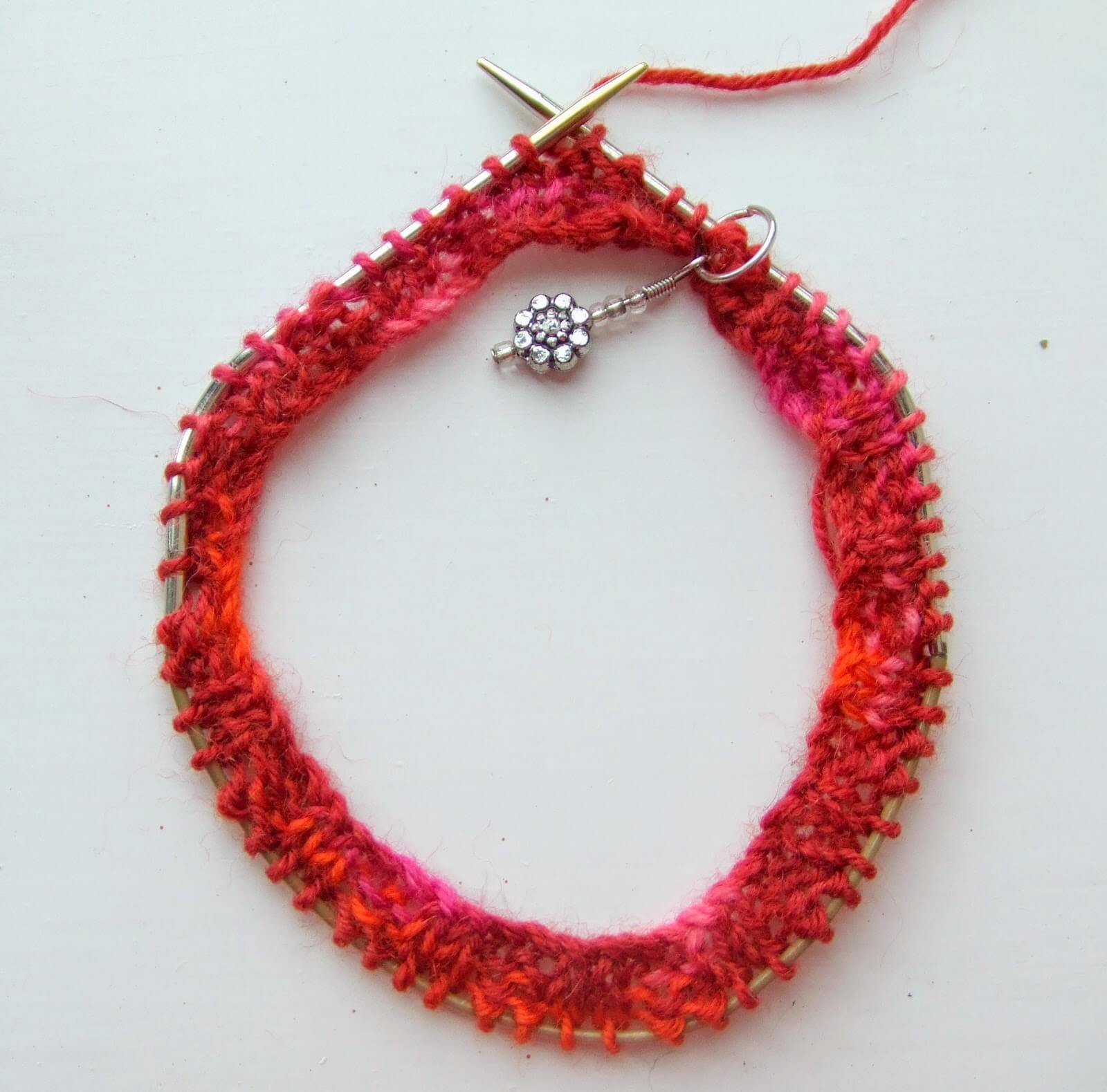
Another thing that you'll need for knitting socks is stitch markers. Apart from my lovely Herdyones, mine were all free gifts from magazines but you can buy them from yarn stores, online or you can simply make your own from a knotted piece of yarn. All a stitch marker needs to do is show you where your round starts and finishes, and the start and finish of any pattern section you may have so they can be as fancy or plain as you like. (More info on accessories here)
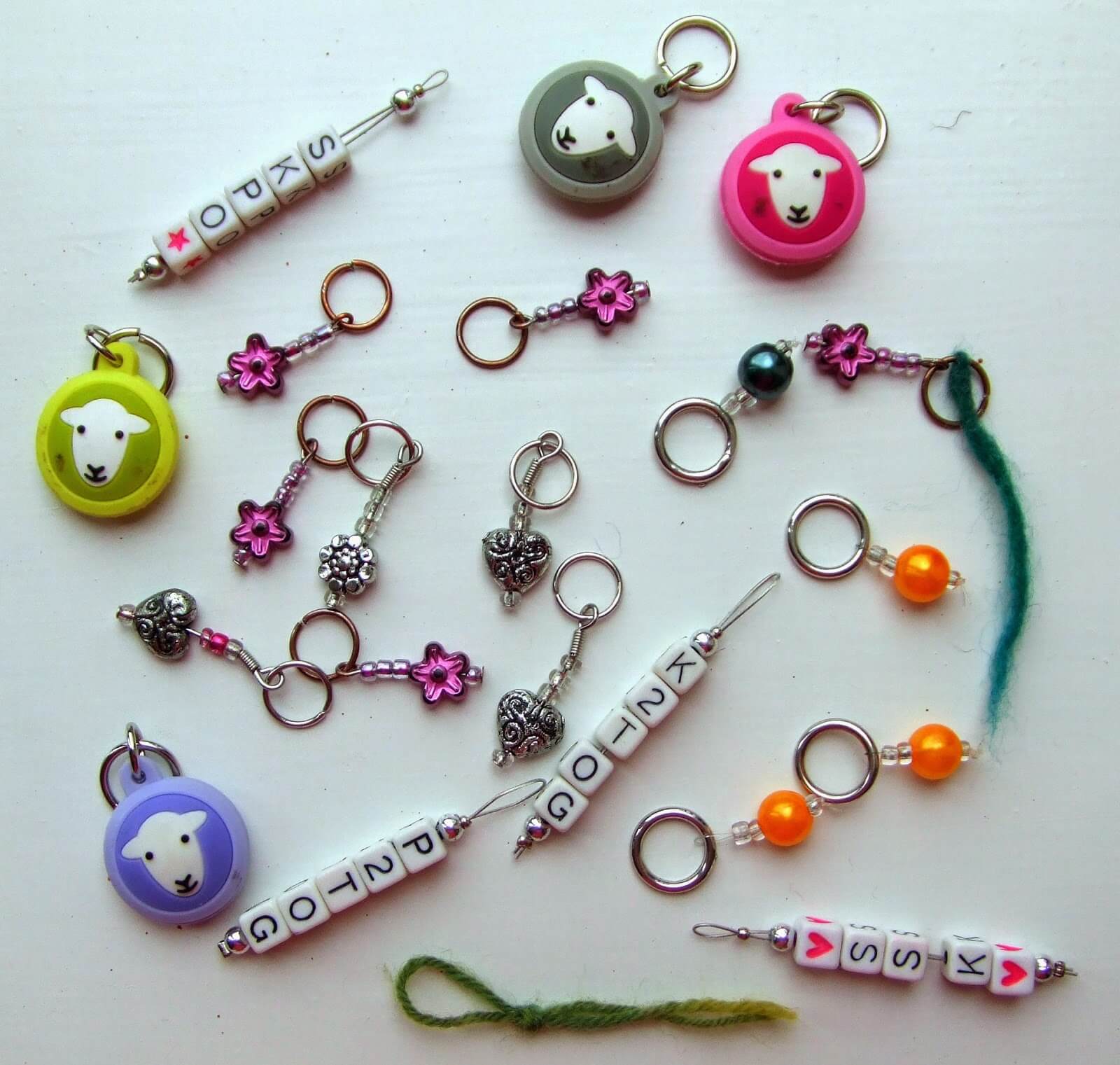
What else? Oh yes, yarn! It's best to use yarn that's specifically for knitting socks because it will usually have a proportion of nylon in the yarn which helps to hold the socks' shape and make them more hard-wearing. Some of the gorgeous hand-dyed skeins that you can buy don't have any nylon in their content but that doesn't mean you can't use it, just that your socks might wear out a bit sooner, especially if they get a lot of use. Most sock yarn is 4ply but you can also buy 6ply, 8ply (and thicker) which is great for boot socks. (You can find out more about suitable yarns here)
Just in case you're interested, my new stripy socks are knitted in Regia Design Line "Random Stripe" shade 02904 Delphinium and the red socks for illustrating this tutorial are knitted in Regia Galaxy shade 1559 Jupiter Red (2021 edit – both now discontinued).
Basic 4ply Socks pattern
– you can download a free PDF copy of the sock pattern here
This is the pattern that's being used for the Winwick Mum Sockalong. You can find more detailedstep-by-step tutorials for knitting this sock here and you can join the accompanying Facebook group for help, support and showing off socks here, our knit n natter group here and the Ravelry group here.
A quick word about gauge before you get started – most people prefer to skip quickly across the recommendations for gauge and tension but in the case of socks, knowing your gauge is really helpful – not least because it can help you to re-size your socks for any foot. The standard gauge for 4ply yarn is 30 sts per 4 inch (10cm) on whatever needles gives you that gauge – formostpeople, that is 2.5mm needles but it's always worth checking just in case you knit tighter or looser than that.
How to adjust the size for this pattern
There is only one size given for this pattern but you can use this as a guide for any other size. Hand knitted socks are measured by width and not length, which is easily adjusted, so to get the perfect fit for the person you are knitting for, it is best to measure their feet first and use theSock Stitch Calculationto find out the right number to cast on. It's very easy to do, and once you have the numbers, you can use them for any pair of socks in the same weight of yarn.
For help checking your gauge in the round (different to gauge worked flat) and how to re-size the pattern for any foot, click here. There's a useful video to help here.
Materials
2.5mm needles – I use a30cm circular needle but DPNs or magic loop will also work
1 x 100g ball of 4ply sock yarn (or 2 x 50g depending on brand)
1 pair DPNs size 3.0mm
1pair DPNs size 2.5mm
stitch markers
tapestry needle
Note: I cast on using DPNs then change to my circular needle – it's not easy to cast on using the circular as it's too small. If you want to use magic loop you will be able to cast on with the larger circular needle. If you use DPNs, you might find it easiest to cast on and work 2 rows before dividing the stitches across the needles.
To adjust the size for this sock, just add or remove stitches in blocks of 4 from the cast on total. For example, if knitting a man's sock I would cast on 64 or 68 stitches. Remember that you will need to make adjustments when turning the heel if you use extra stitches. There's a calculation for working out the number of stitches you need as mentioned above in the tension section here.
Pattern
Cast on 60 stitches using 3.0mm needle. Need help with casting on? Click here!
Row 1: K2, P2, repeat to end, turn
Row 2: K2, P2, repeat to end, turn
Change to 2.5mm needles. At this point, change to a short circular, magic loop or divide the stitches across DPNs and join into a circle, place marker.
Continue in K2, P2 rib for 14 more rounds or until desired length of rib (I knit 16 rounds of rib).
Continue to knit each round until desired length before start of heel (for me, this is about 75 rounds in total including the rib).
Heel flap
Change to 2.5mm DPNs. You are going to create the heel flap from half the number of stitches that you cast on, so if you have cast on more or less than 60 stitches, remember to adjust the number of stitches when you start the heel flap.Need help with the heel flap? Click here!
Row 1: K2, (Sl1, K1) until you have 30 stitches on your needle, turn.
Row 2: Sl1, P to end, turn.
Row 3: Sl1, (K1, Sl1) to end, turn.
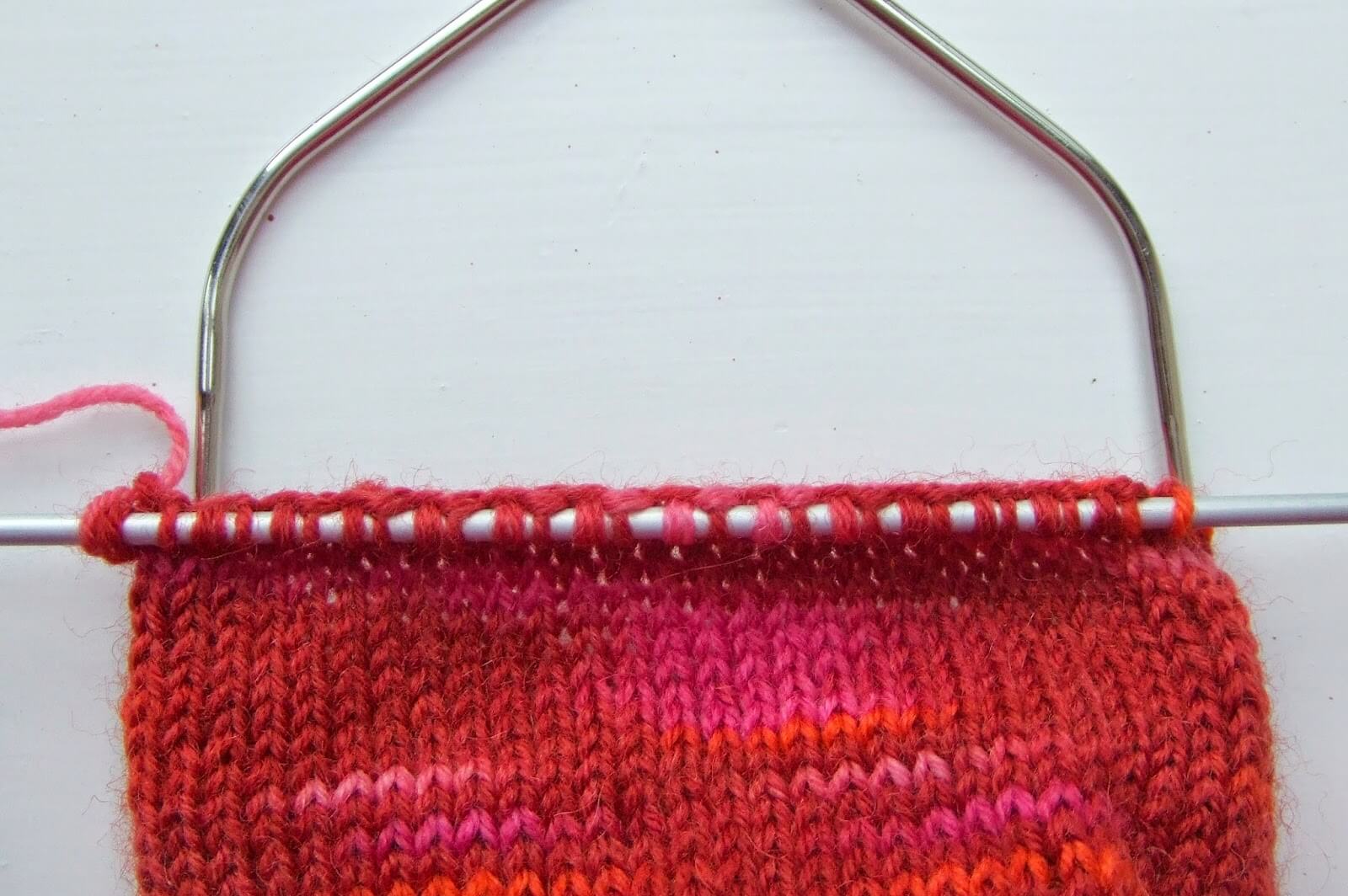
At this point, I usually tuck the ends of my circular needle down inside my sock so that it doesn't get in the way. If you are using DPNs for the entire sock, you may prefer to put the spare stitches onto a stitch holder whilst you work the heel.
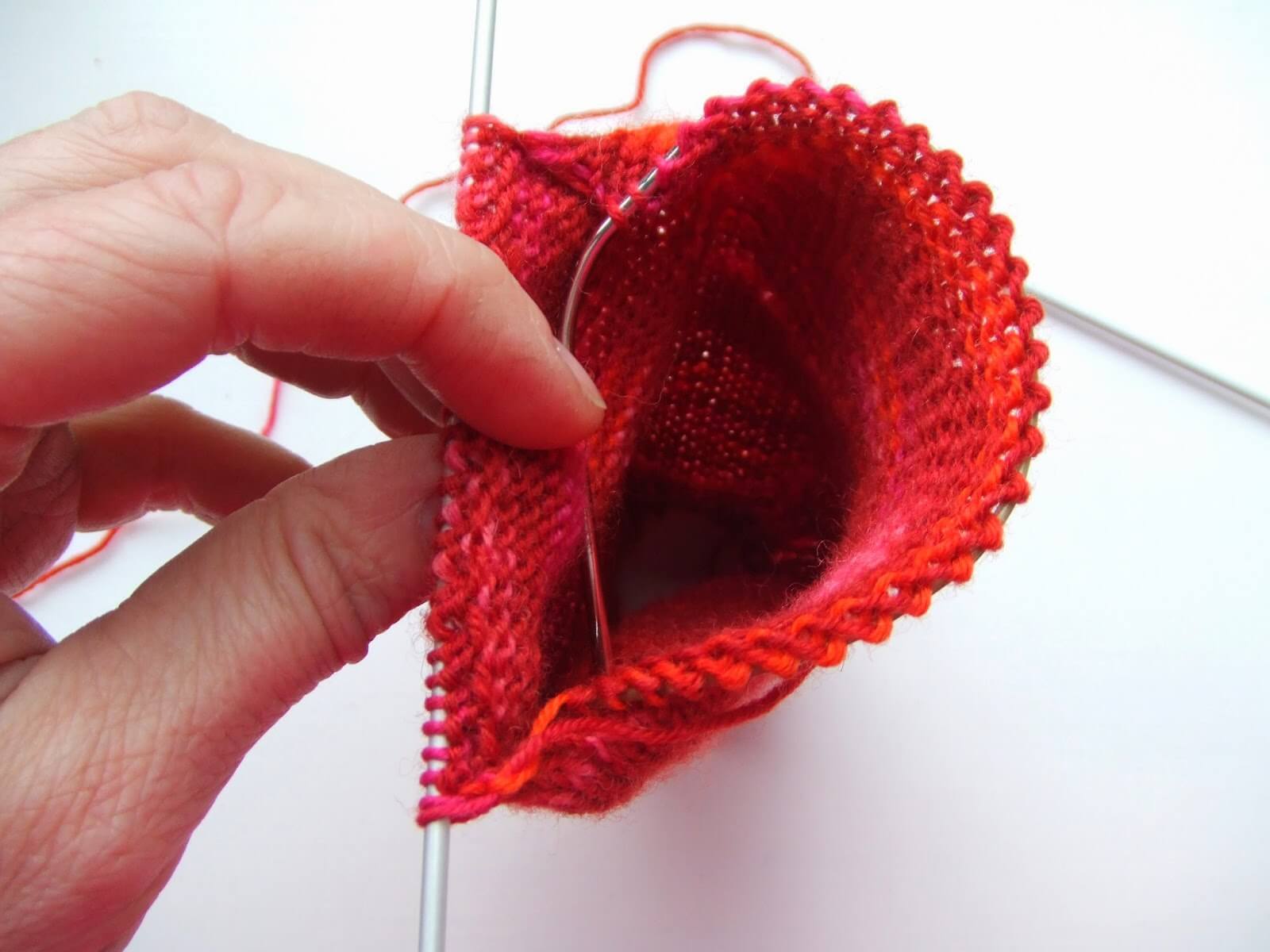
Repeat rows 2 and 3 until heel measures approximately 2 inches, finishing on row 3 (approx 35 rows) . If you want to make the heel flap longer, continuing knitting rows 2 and 3 until you reach the desired length, but remember that you will need to pick up more stitches to create the gusset.
This is what the heel flap looks like when it's finished. Slipping every other stitch gives a raised texture that is thicker than just knit and purl which is ideal for a sock heel.
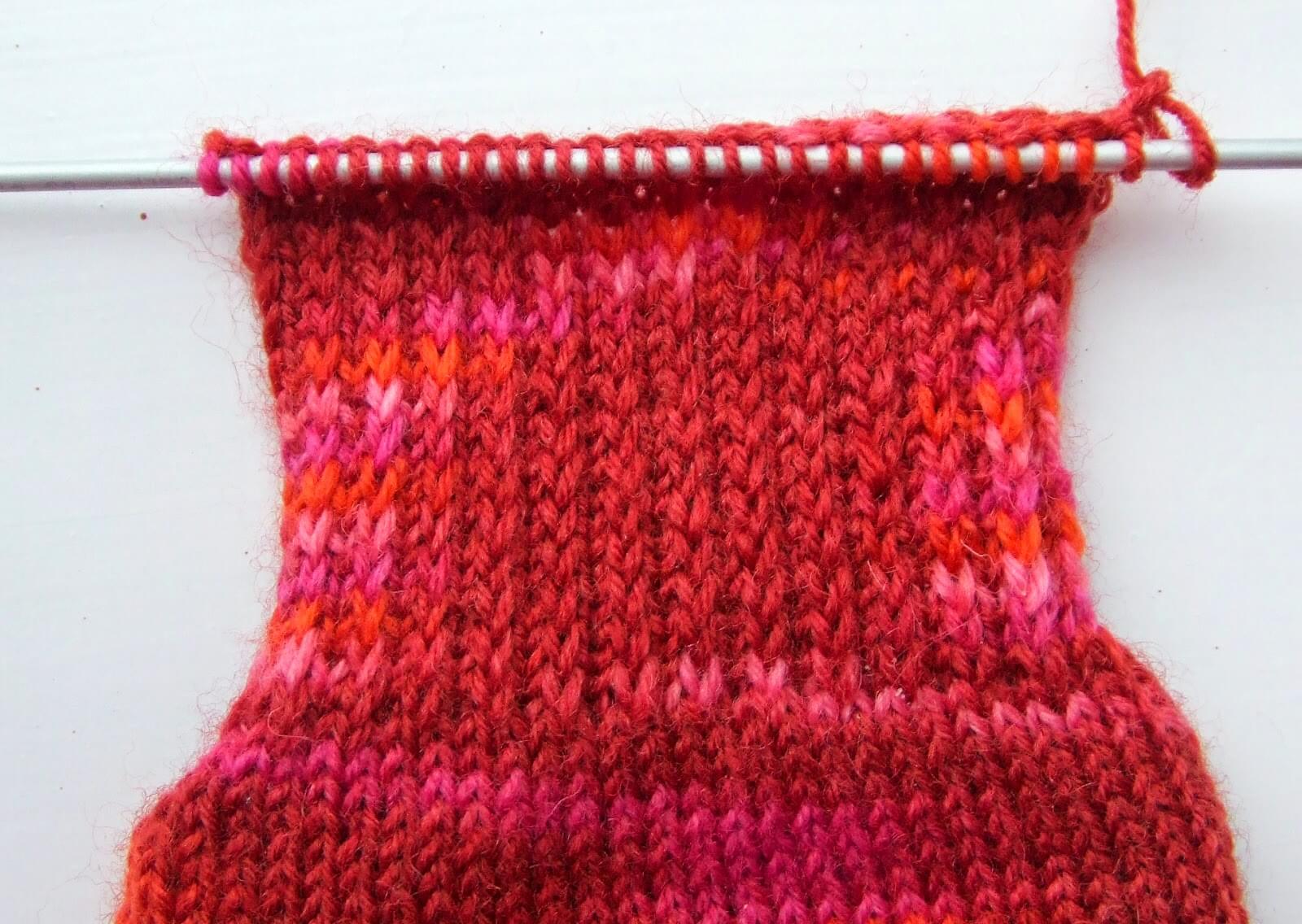
This is what it looks like on the purl (wrong) side.
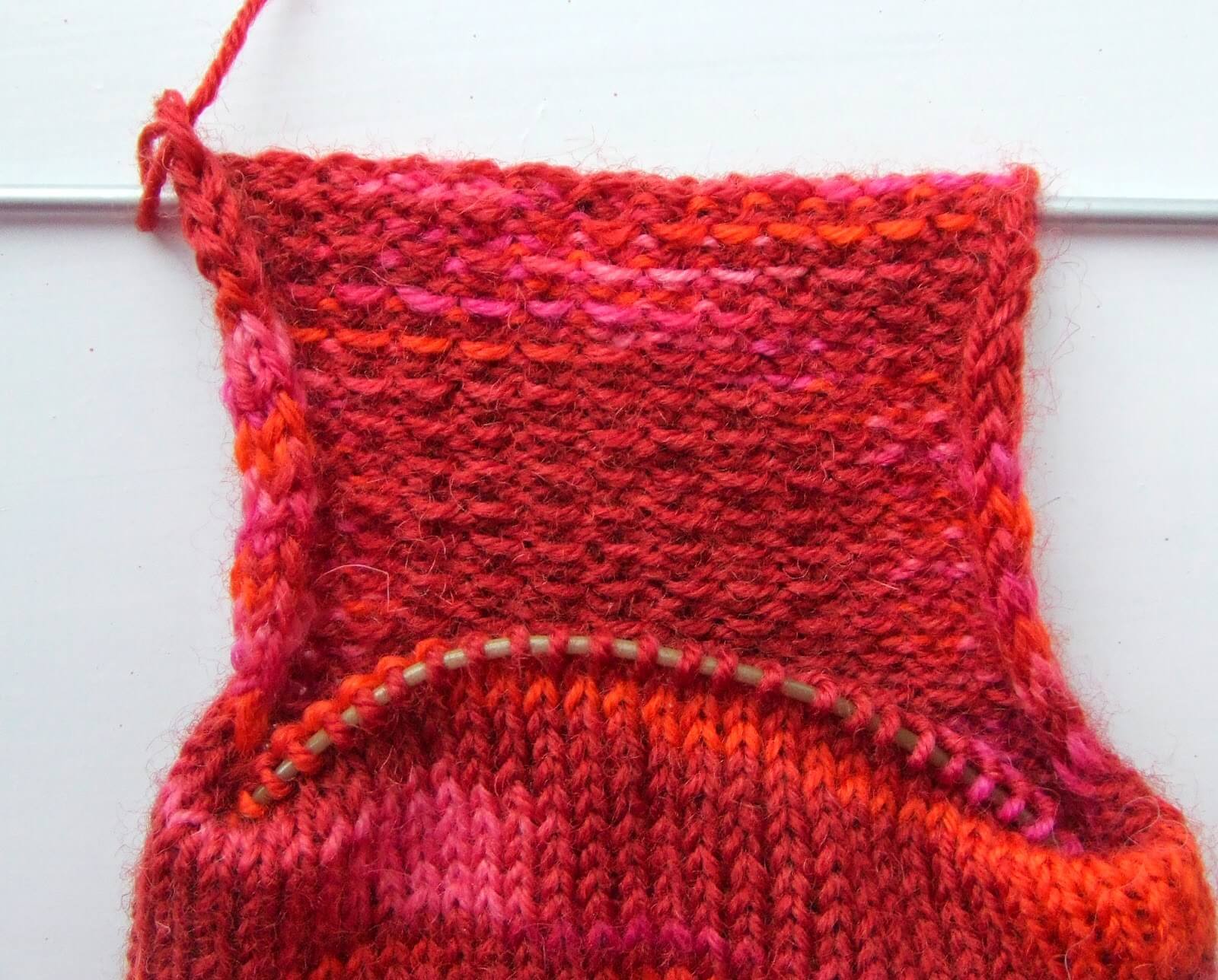
Turn heel
Now, this is the fun part and the one that puts a lot of people off, but it's quite easy as long as you take it slowly.Need help turning the heel? Click here!
*For a larger or smaller sock, you will need to alter the number of purl stitches in the first row of the heel (marked in bold below), increasing by 1 stitch for each block of 4 stitches extra that you cast on, or decreasing by 1 stitch for each block of 4 stitches less than 60 stitches. For example, if you cast on 64 stitches, your first row would be Sl1, P17, P2tog, P1, turn*
Row 1: Sl1, P16, P2tog, P1, turn
Row 2: Sl1, K5, SSK, K1, turn
Row 3: Sl1, P6, P2tog, P1, turn
Row 4: Sl1, K7, SSK, K1, turn
Continue in this way, adding one stitch between slip stitch and SSK or P2tog on each row until all of the heel stitches are used (ie, Row 5: Sl1, P8, P2tog, P1; Row 6: Sl1, K9, SSK, K1, etc) until all of the heel stitches are used. Depending on how many stitches are in your heel flap, you may find that the K1 and P1 stitch is not required at the end of the last two rows.
As you work these rows, you'll notice that there's a gap between the end of your knit or purl stitches in the middle and the remaining stitches to be worked into the heel. This will help you to work out where you're up to.
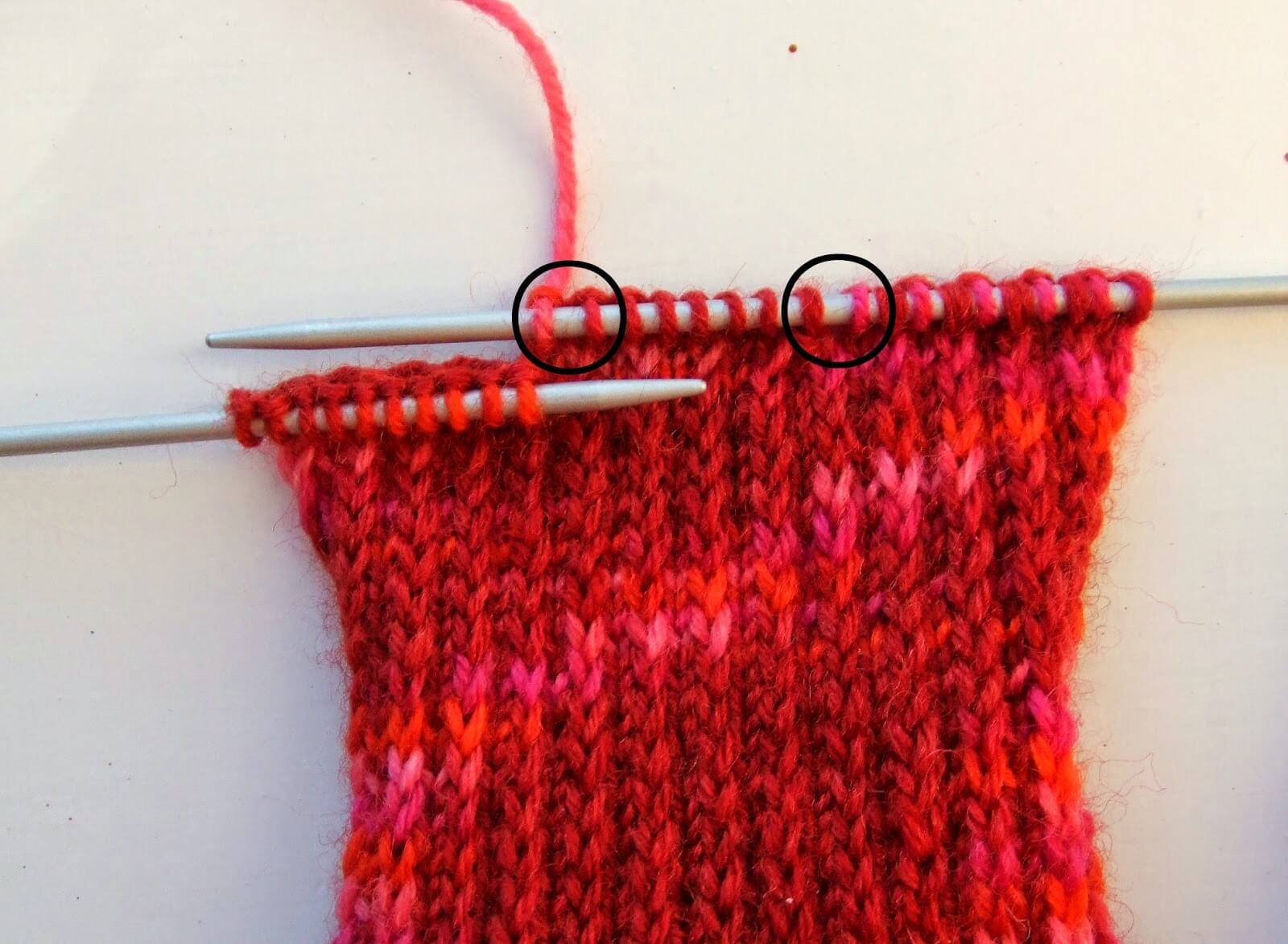
When you work the SSK or P2tog stitches at the end of each row, you take one stitch from each side of the gap and that's what pulls the heel round into the right shape.
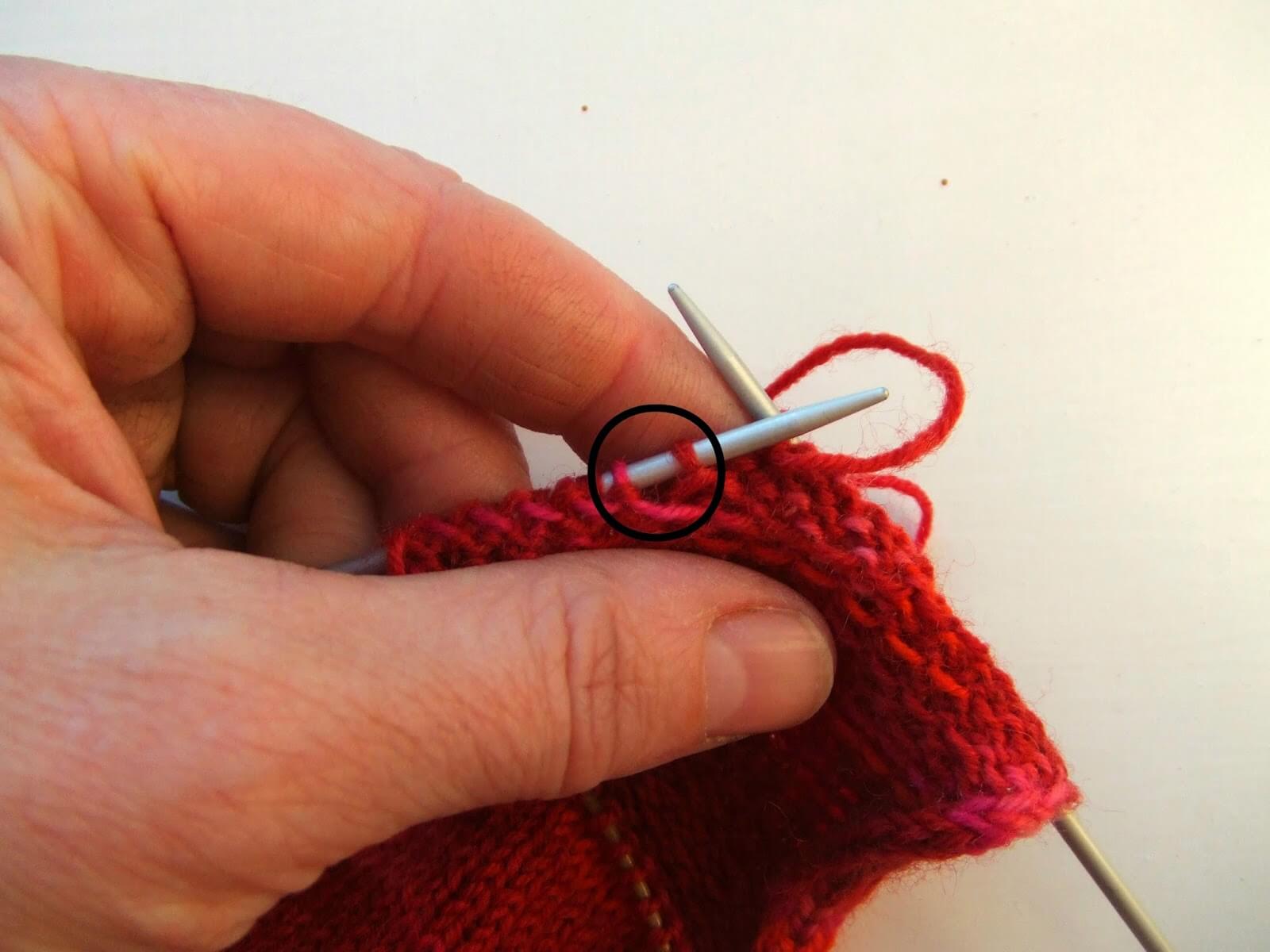
This picture illustrates the SSK stitch – slip the first stitch as if to knit, the second stitch as if to purl, slip them both back onto the left hand needle and knit through the back of the stitches. This gives you a much neater decrease stitch than K2tog.
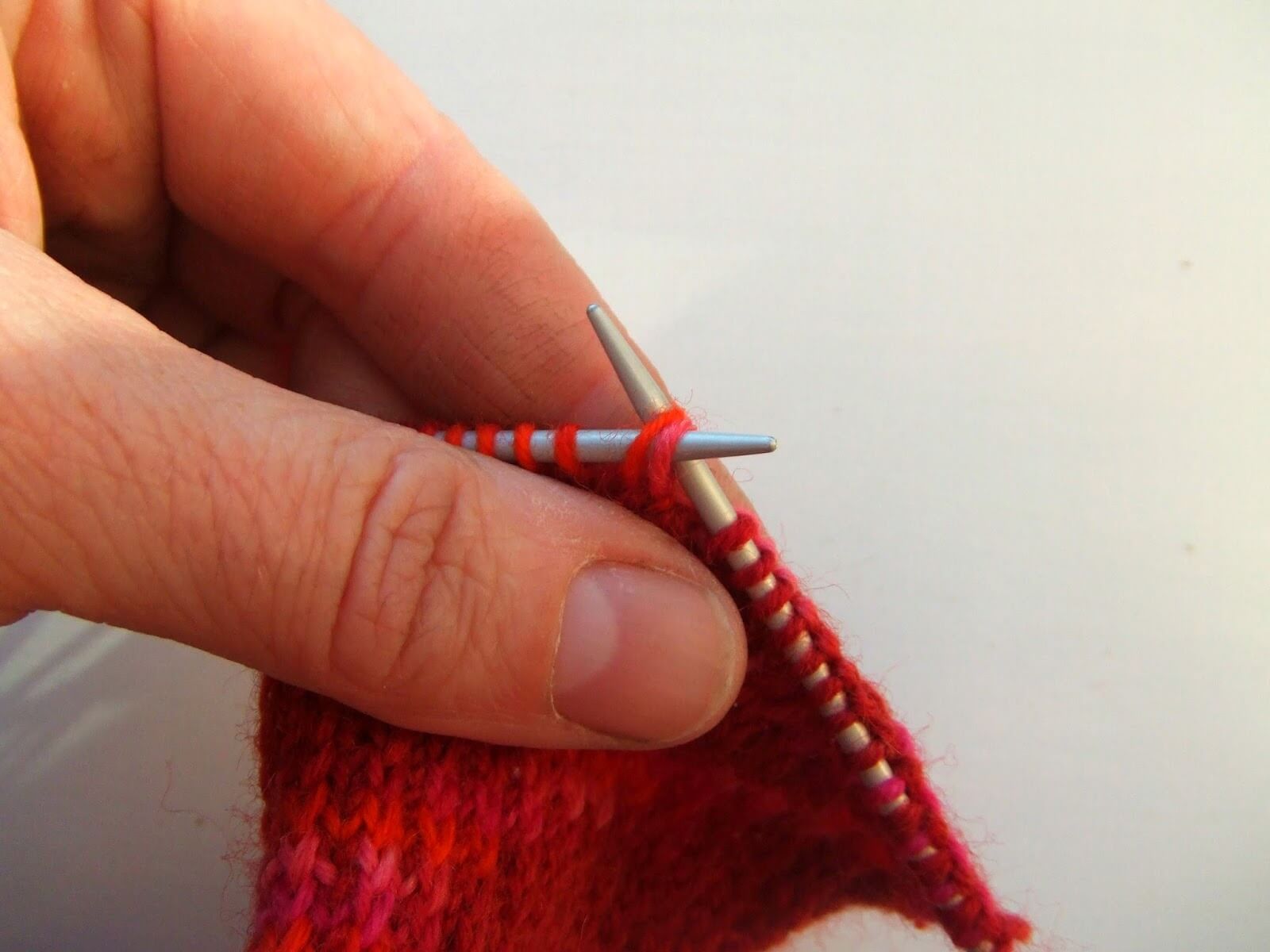
This is what the SSK looks like on the right side of the sock …
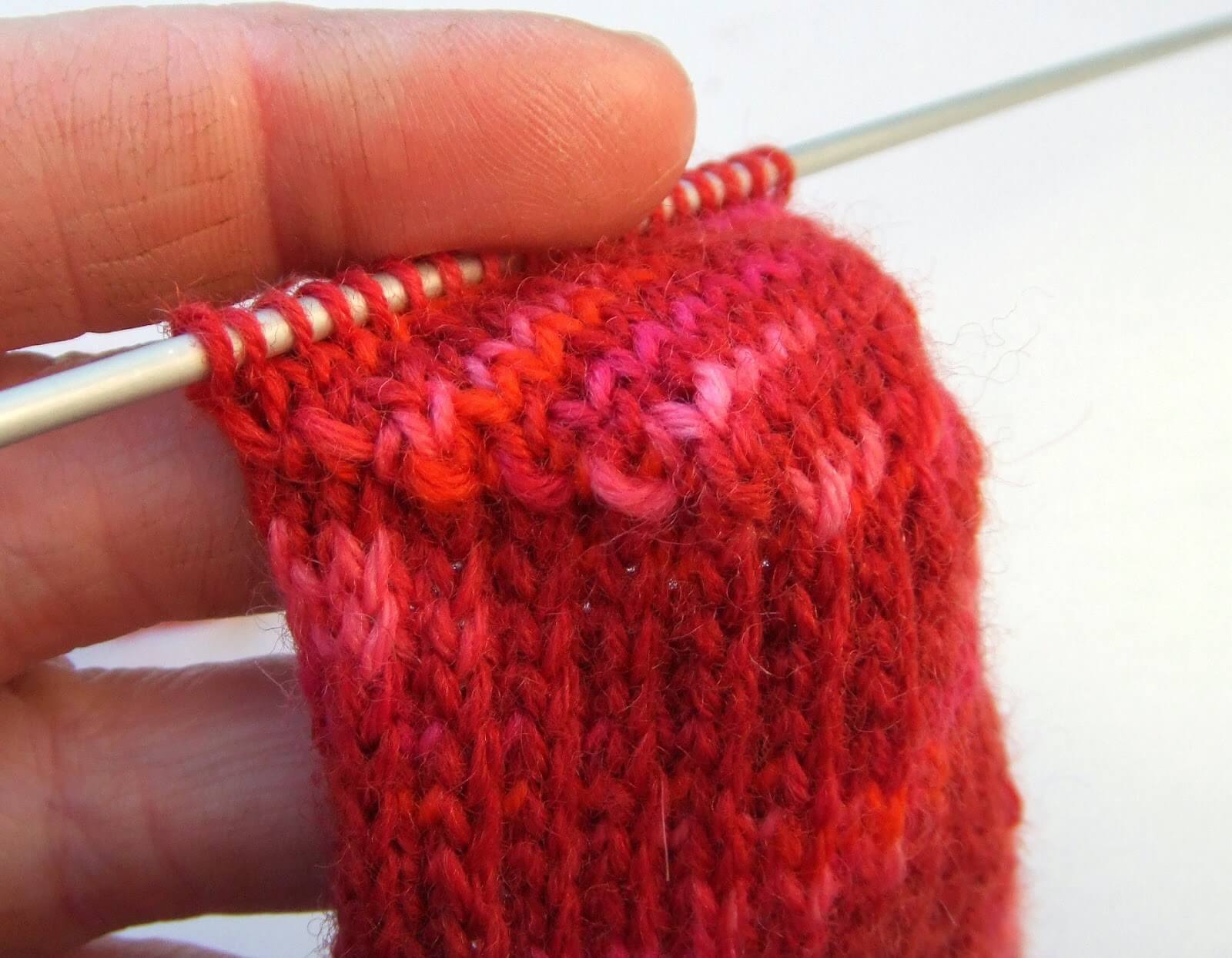
and this is what the P2tog looks like. It gives a nice neat finish to your heel with no gappy holes.
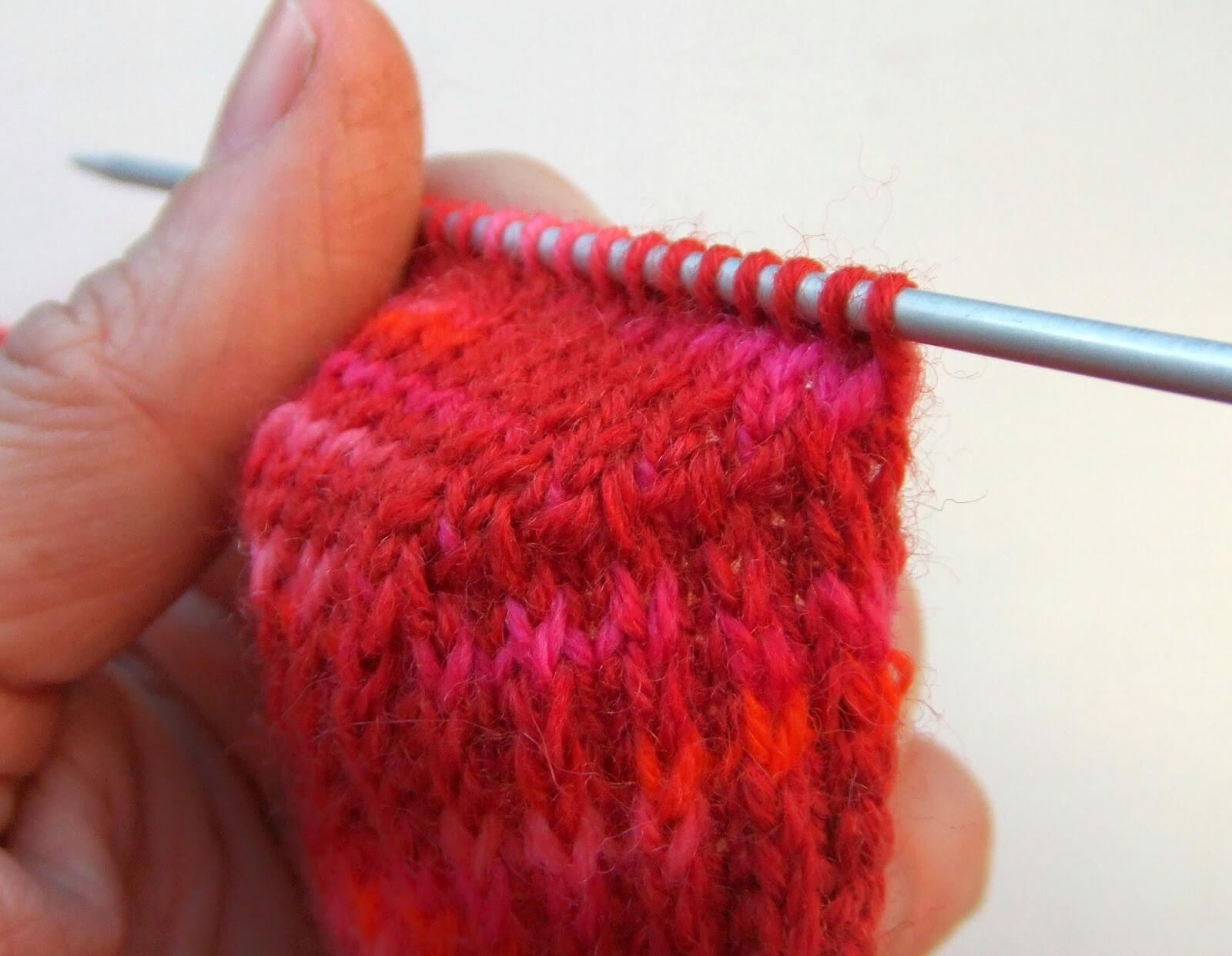
Knit across the heel stitches if required to bring you to the left hand side of the heel ready to pick up 19 stitches. It works out as 1 st per every 2 rows of heel flap knitted so remember that if you made the heel flap bigger, you will need to pick up more stitches.
The reason that you used a slip stitch in the heel flap is to make it easier to pick up the gusset stitches. You can see in this picture the slipped stitches are the row of larger stitches lying flat against the flap. I pick up the inside loop to create my new stitch.
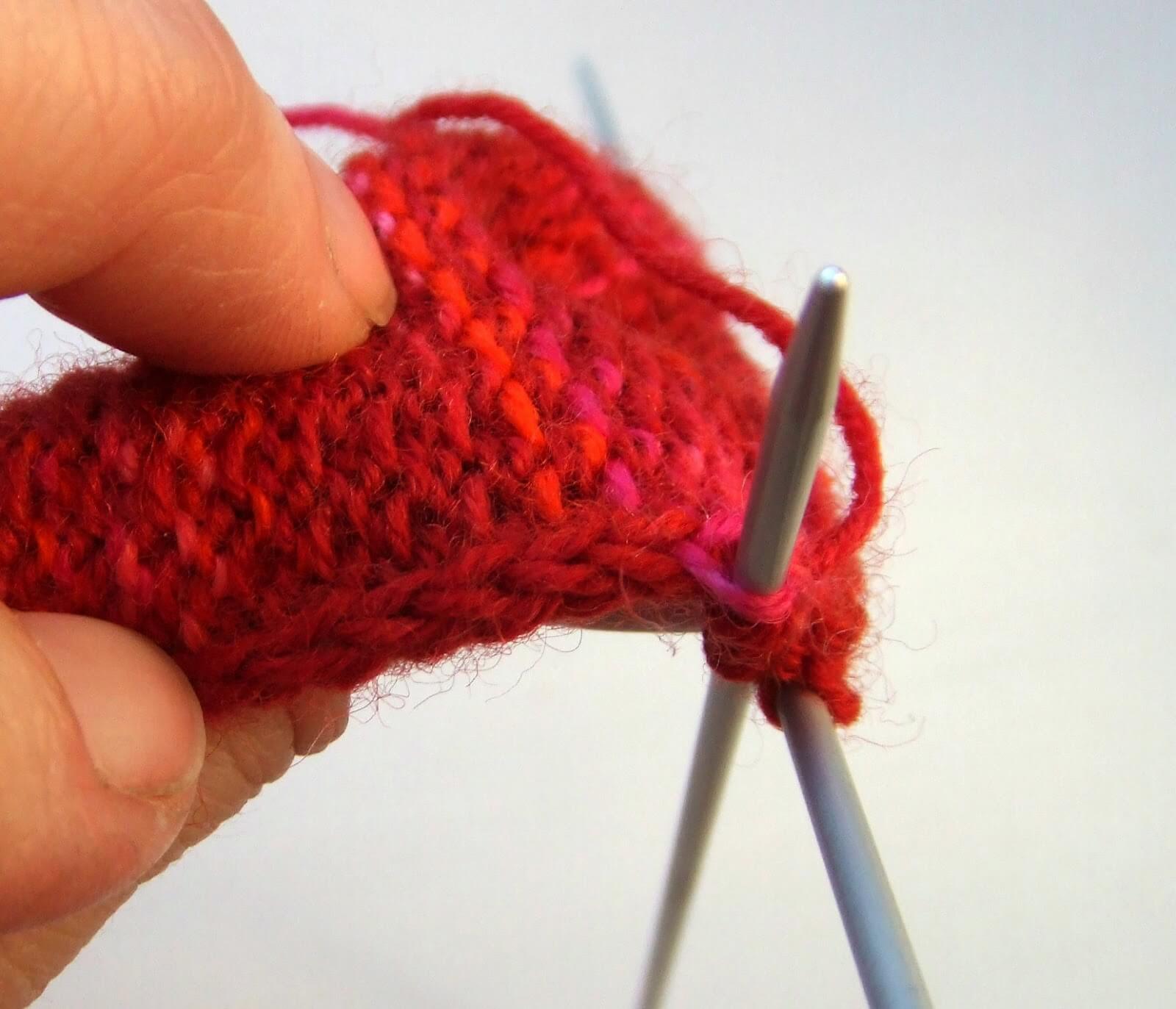
This picture shows how the row of slip stitches looks once you've picked up all the gusset stitches.
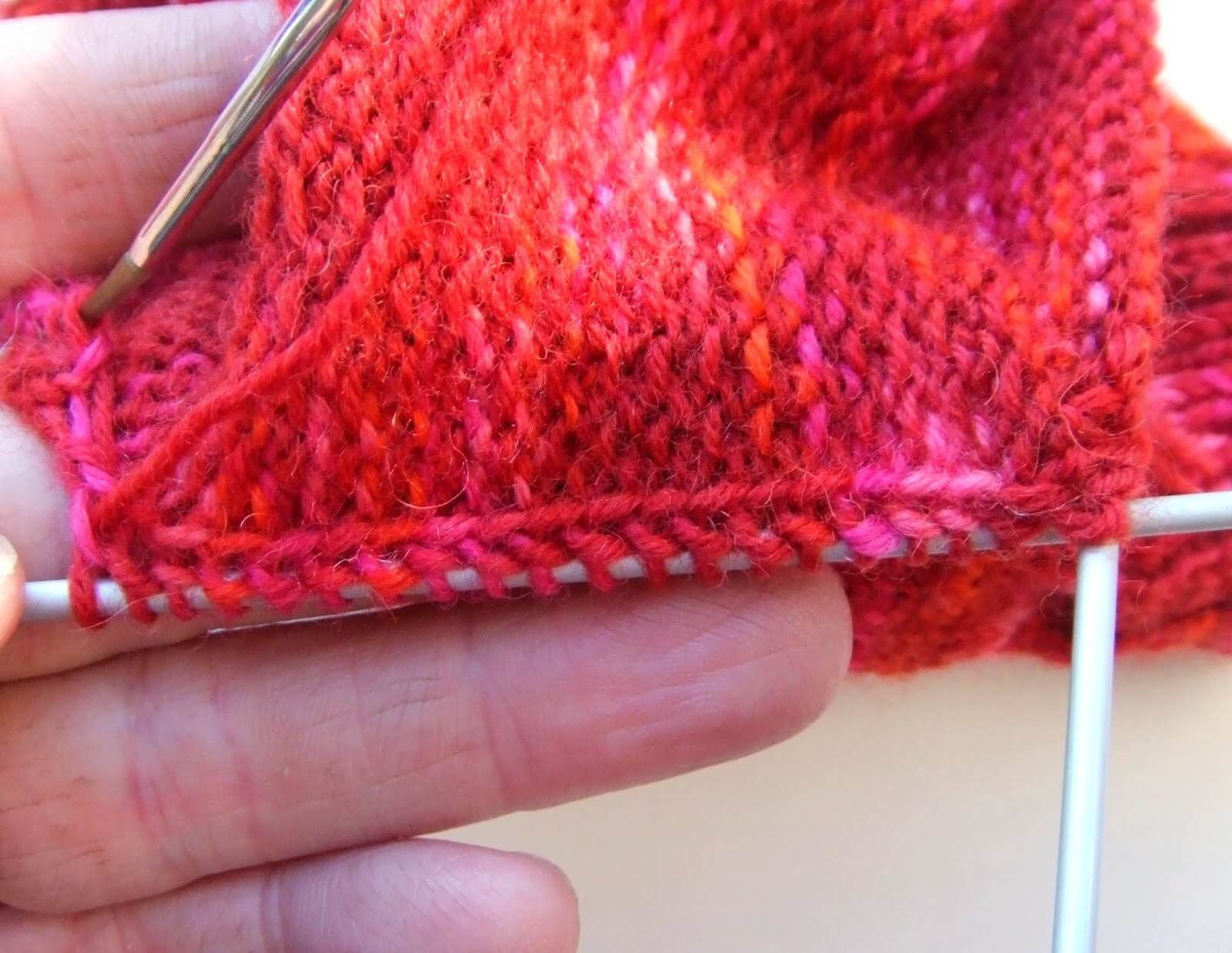
Once you have picked up the stitches, place marker to indicate the new beginning of the round. Knit across the top of the foot (I usually knit back onto my circular needle at this point), place marker, then pick up 19 stitches (or more if required) up the other side of the heel. It works out at 1st per every 2 rows knitted in your heel flap so you may have more or less. Knit across the top of the heel and then shape gusset as below.
Note: If you are using DPNs and/or have placed your stitches on a stitch holder, you can arrange the needles as follows: Needle 1 for stitches across heel, Needle 2 for picked-up stitches down side of foot, Needle 3 for stitches across top of foot (knit stitches off stitch holder if required), Needle 4 for picked-up stitches on other side of foot. You may find that stitch markers are not required at first.
Shape gusset
Round 1: K to 3 sts before the marker, K2tog, K1, slip marker, knit to next marker, slip marker, K1, SSK, K to marker.
Round 2: Slip marker, knit to next next marker, slip marker, knit to 3 sts before marker.
Round 3: K2tog, K1, slip marker, knit to next marker,s lip marker, K1, SSK, K to marker.
Repeat rounds 2 and 3 to shape the gusset and continue in this way, decreasing by two stitches at the gusset on every other row until there are 60 stitches on the needle. If you want to take out the SSK marker you can do that now, but leave the other one on to indicate the beginning/end of your round.Need help with the gusset? Click here!
You can see the line where the decreases create the gusset quite clearly in this picture.
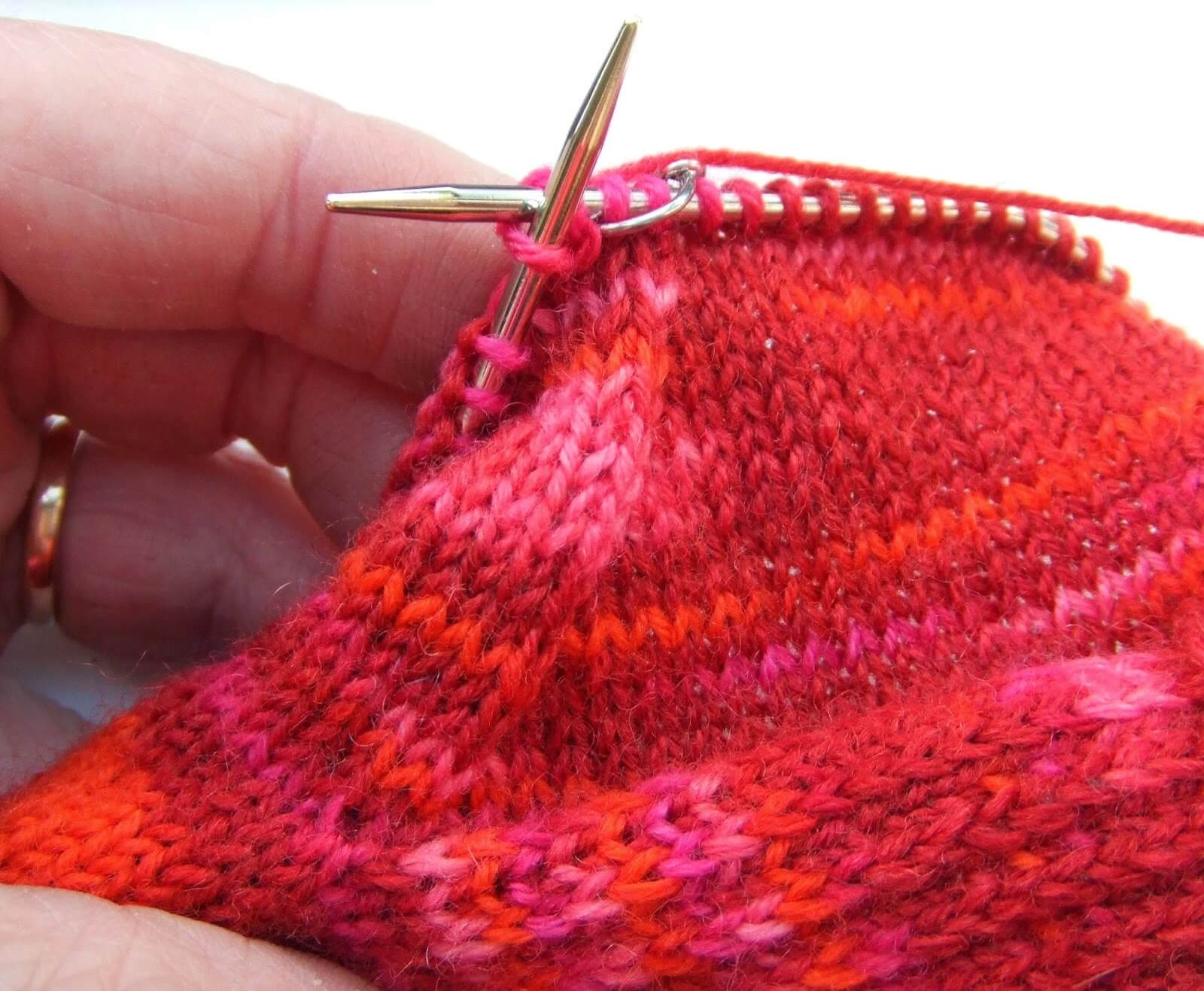
Once you have 60 stitches again, continue to knit each round until you reach approximately 2.5in;5cm before the desired length ready to start the toes. For my UK size 5 feet, this is about 47 rounds. Don't be afraid to try your sock on before decreasing for the toes!
Toes
At some point whilst decreasing for the toes, if you are using a small circular you will need to change back to DPNs as the number of stitches becomes too small for the circular. It's up to you when you choose to do that, and how you distribute the stitches across the needles; just keep following the pattern as set below. Need help with the toe decreases? Click here!
Create the toes as follows:
Round 1: K1, SSK, K24 sts, K2tog, K1, place marker (if required), K1, SSK, K24 sts, K2tog, K1.
Round 2: Knit one round, slipping markers as you come to them.
Round 3: K1, SSK, K to 3 sts before marker, K2tog, K1, slip marker, K1, SSK, K to 3 sts before marker, K2tog, K1.
Repeat rounds 2 and 3 until you have 28 stitches left and divide these between two needles so that front and back of socks match (14 stitches on each needle).

Graft toes using Kitchener stitch. This is another part of the sock-creation that some people aren't so keen on, but again it's not too bad if you take it slowly. Cut a long length of yarn and thread it onto a wool needle. I'm giving you right-handed instructions here. Need help with the Kitchener Stitch? Click here! You can also see how I do this in a video here (it's a different pattern but the process is the same!
Note: the following instructions show the Kitchener stitch with set up stitches – some people find this gives them an "ear" at the end of their sock so if you prefer, you can miss out steps 1 and 2 and start at step 3.
1 Hold the two DPNs with your left hand. Insert the wool needle purl-wise into the first stitch on the front DPN and pull the yarn through. Don't take the stitch off the DPN.

2 Next, insert the wool needleknit-wise into the first stitch on the back DPN. Don't take the stitch off.
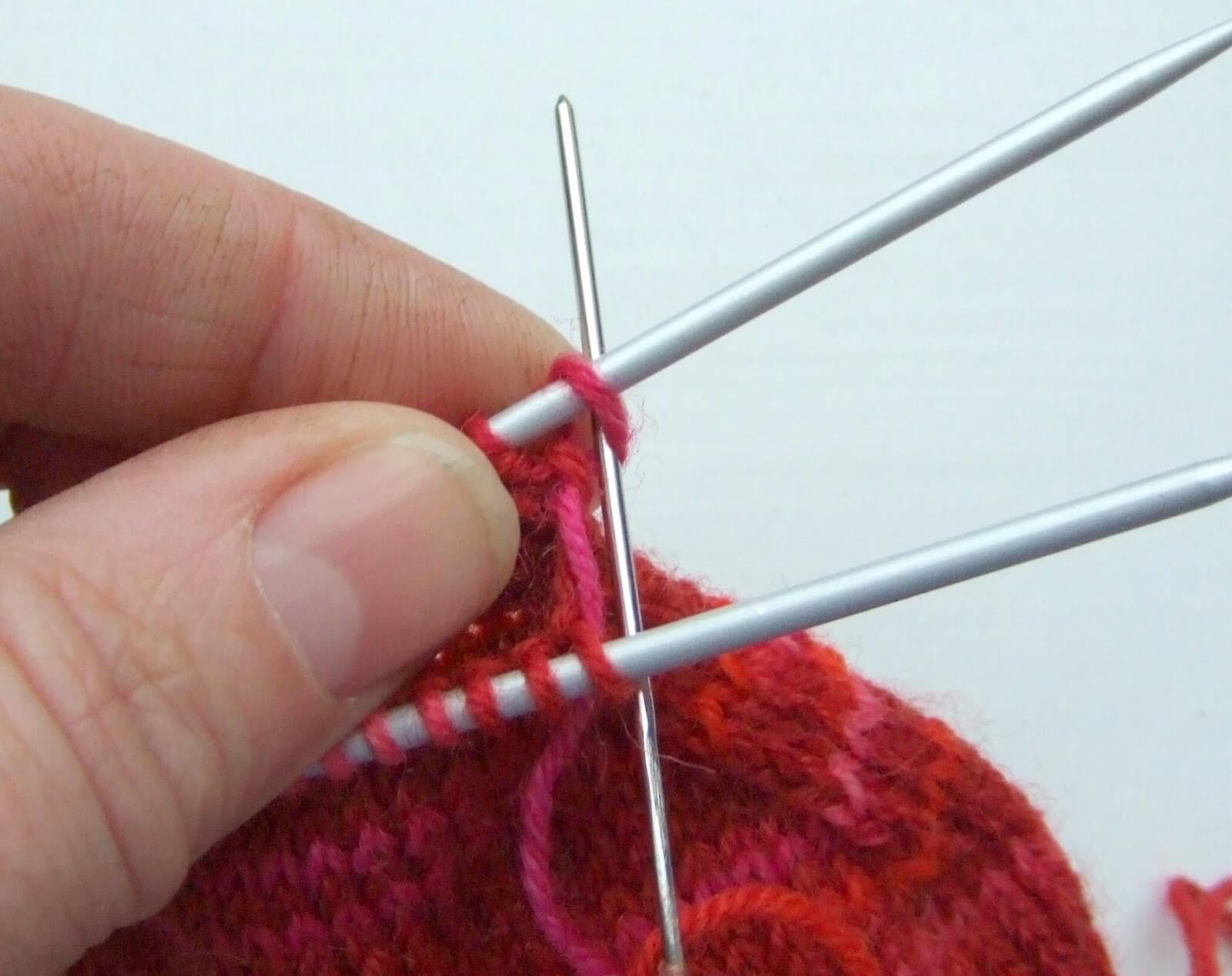
3 Insert the wool needle knit-wise into the first stitch on the front DPN and slip it off.
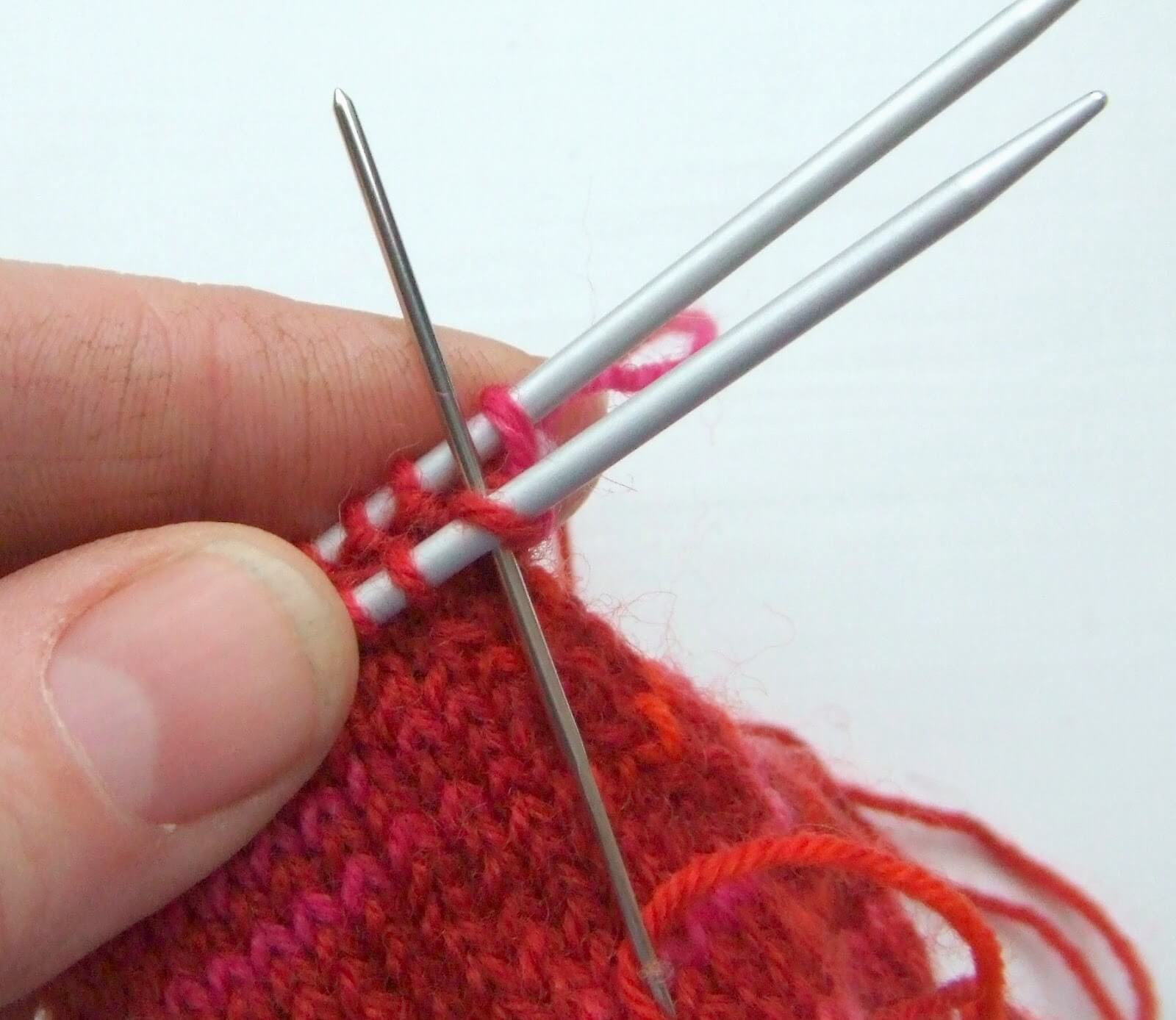
4 Insert the wool needlepurl-wiseinto the second stitch on the front DPN and don't slip it off.

5 Insert the wool needle purl-wise into the first stitch on the back DPN and slip it off. (I've already slipped it off in the photo below!)
6 Insert the wool needleknit-wiseinto the second stitch on the back DPN and don't slip it off.

Repeat steps 3 to 6 until you get to the last two stitches on the DPNs. You will already have taken the yarn through the front stitch so after you have taken the yarn through the back stitch, you can slip both stitches off the DPN. The single yarn thread through the first stitch will be strong enough to hold it and it will sit flatter when you weave the end back into your sock (ie, you won't get an "ear").

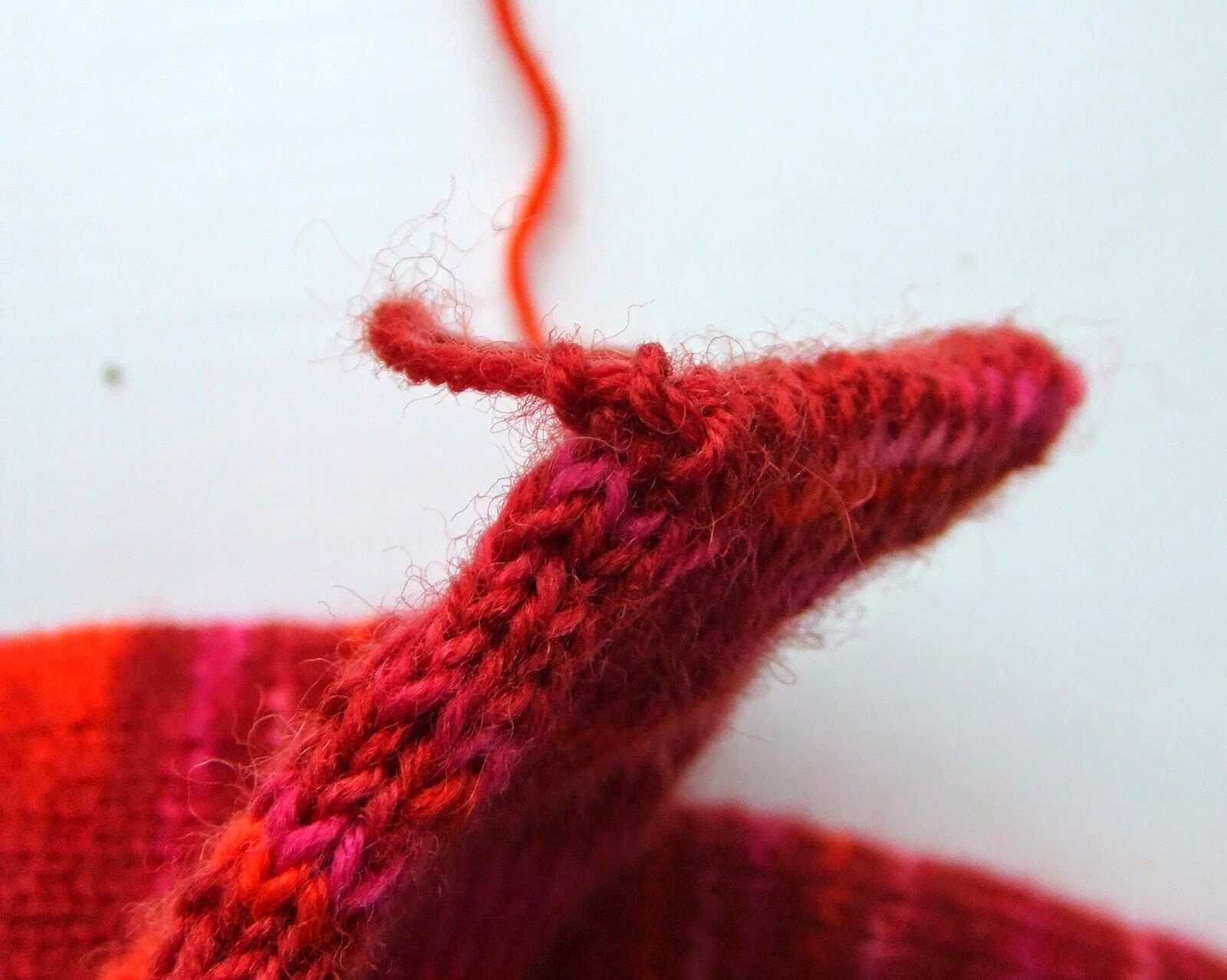
5 Weave the end securely into the sock and cut the yarn.
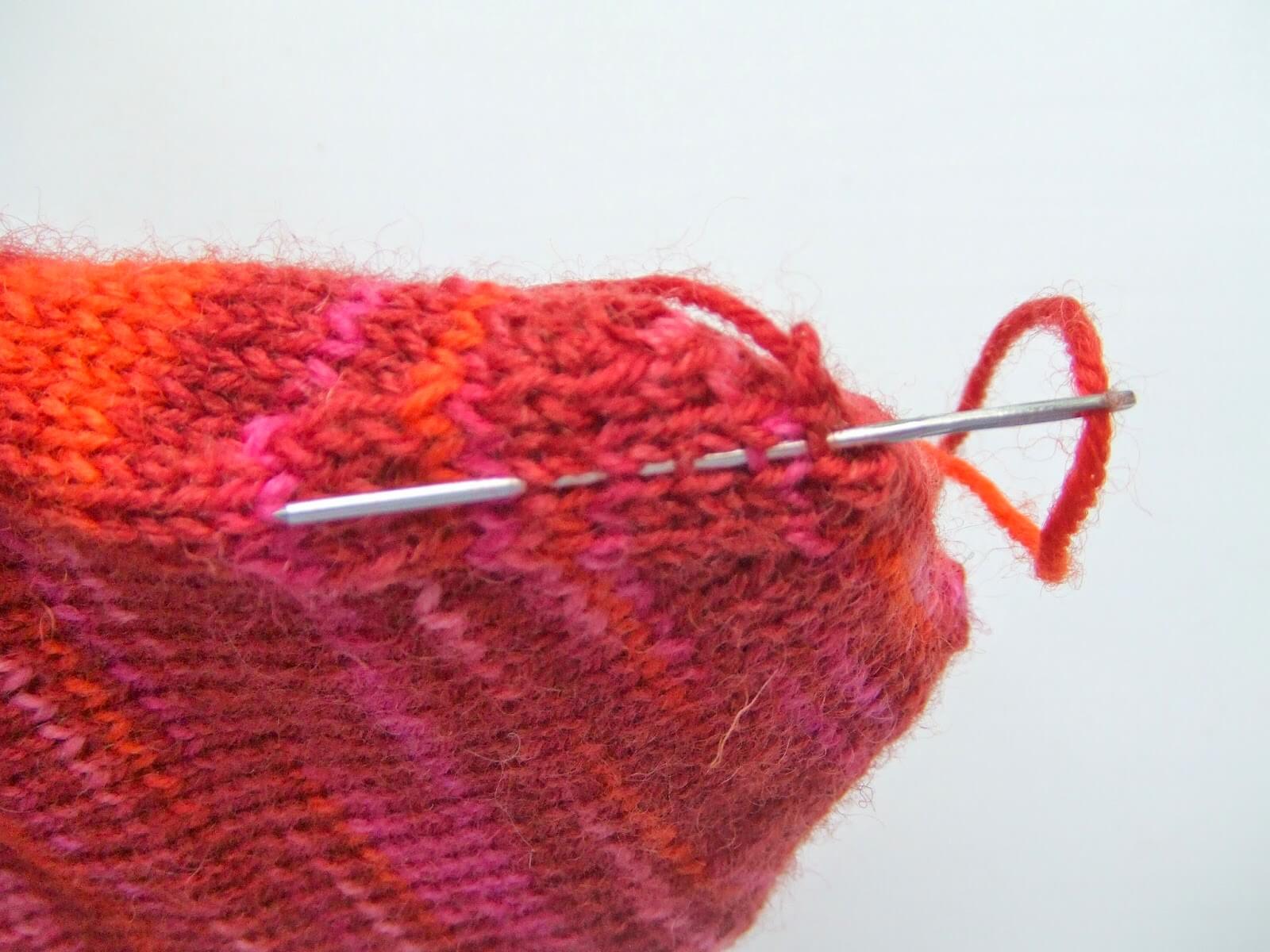
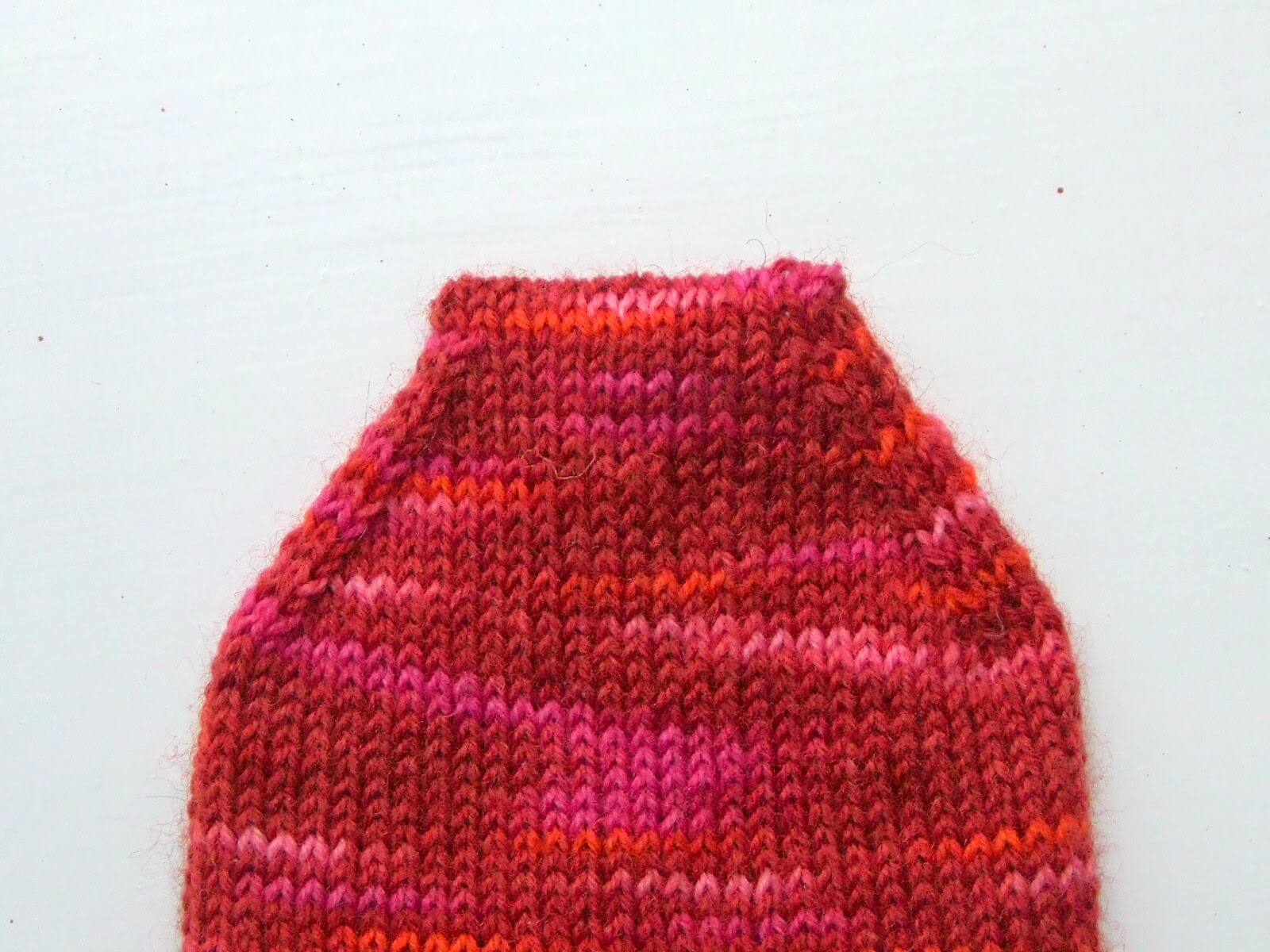
And that's it – you're done! Make two socks if you don't want to hop everywhere and wear them with pride! If you're on Ravelry, please link your project to the pattern here so that I can see your socks – I always love seeing new pairs of socks!
This sock pattern is free and will always remain so, but if you have enjoyed using it and would like to make a donation towards future projects, it will be gratefully received! You can find the donation button on the sidebar on the left hand side. Thank you! xx
This pattern copyright © 2014 Winwick Mum (updated 2021)
Not to be included in any collection or used for profit without written consent of Winwick Mum.
Post Views: 552,464
Knitting Pattern for Socks on Four Needles Uk
Source: https://www.winwickmum.co.uk/2014/05/basic-sock-pattern-and-tutorial.html
0 Response to "Knitting Pattern for Socks on Four Needles Uk"
Post a Comment